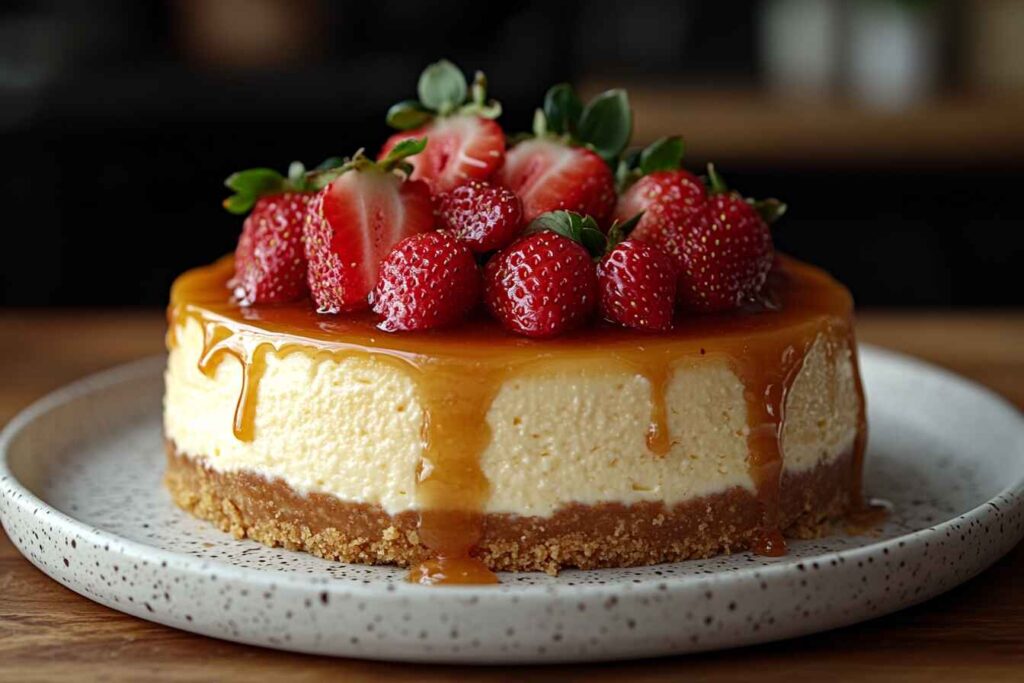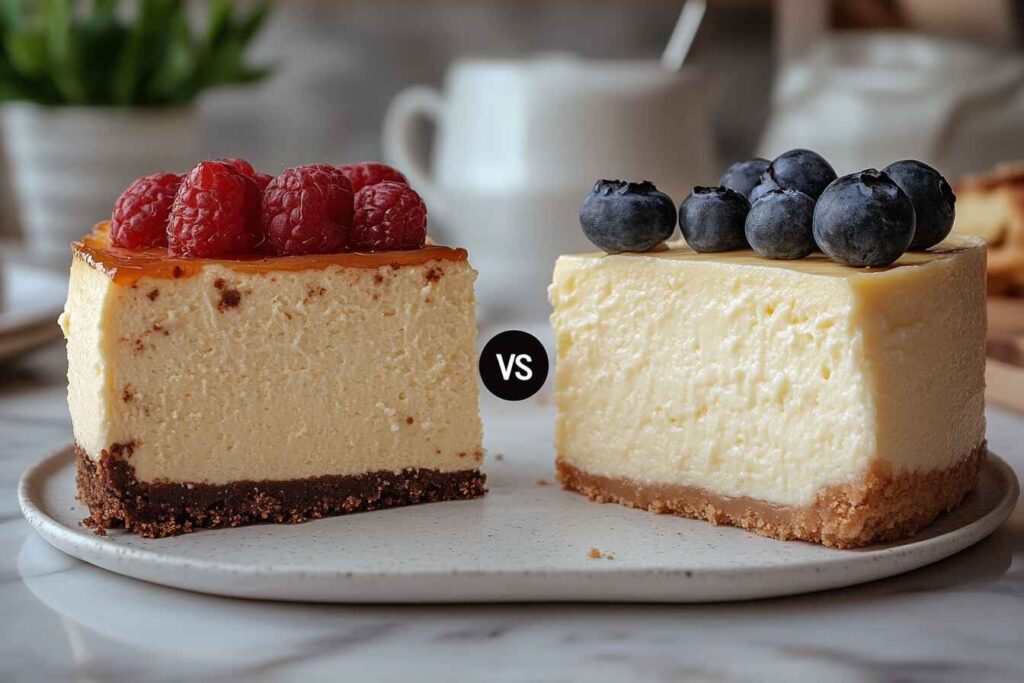Cheesecake is one of those desserts that can make anyone’s mouth water just by hearing the name. That rich, creamy texture, the buttery crust, and the smooth, velvety taste—it’s a slice of heaven on a plate. But did you know that not all cheesecakes are the same? If you’ve ever had a slice of New York cheesecake and then tried a classic cheesecake, you probably noticed some major differences.
So, what exactly sets them apart? Is it the ingredients, the texture, or the way they’re baked? In this guide, we’ll break down everything you need to know about New York cheesecake vs. classic cheesecake. By the time you’re done reading, you’ll know exactly which one to bake for your next dessert craving!
Fun Fact: Cheesecake has been around for over 4,000 years! Ancient Greeks made the first version using simple ingredients like honey and cheese.
What is Classic Cheesecake?
Let’s start with the basics—classic cheesecake. This is the traditional version that most people think of when they hear “cheesecake.” It’s the foundation for all the other variations, including the famous New York-style cheesecake.

Origins and History of Classic Cheesecake
Classic cheesecake has a long and fascinating history. It dates back to ancient Greece, where people would mix soft cheese with honey and wheat to create a primitive version of the dessert. The Romans later adopted the recipe, adding eggs to make it richer. Over the centuries, different regions put their own twist on the dish, but the idea remained the same—creamy, slightly tangy, and sweet.
Today, classic cheesecake is known for its balanced texture—not too dense, not too fluffy. It’s usually made with a simple graham cracker crust, a smooth cream cheese filling, and sometimes topped with fruit, chocolate, or caramel.
Ingredients Used in Classic Cheesecake
While different recipes vary, here are the standard ingredients in a classic cheesecake:
| Ingredient | Quantity |
|---|---|
| Cream Cheese | 16 oz (2 blocks) |
| Sugar | 3/4 cup |
| Eggs | 3 large |
| Sour Cream | 1/2 cup |
| Vanilla Extract | 1 teaspoon |
| Graham Cracker Crumbs | 1 1/2 cups |
| Butter (melted) | 1/4 cup |
The balance of these ingredients gives classic cheesecake a light yet rich taste without being overly heavy.
Texture and Flavor Profile of Classic Cheesecake
Classic cheesecake has a **smooth, creamy texture with a light and airy consistency**. It’s soft enough to melt in your mouth but firm enough to hold its shape when sliced. The flavor is sweet with a slight tang from the cream cheese, making it a well-balanced dessert.
Did You Know? The tangy flavor in cheesecake comes from the lactic acid in cream cheese!
Baking Methods for Classic Cheesecake
Classic cheesecakes can be baked or no-bake, depending on the recipe. However, most traditional versions require baking. Here’s how it’s typically done:
- **Preheat the oven** to 325°F (163°C).
- **Prepare the crust** by mixing graham cracker crumbs with melted butter and pressing it into a springform pan.
- **Mix the filling** by beating cream cheese, sugar, and eggs until smooth.
- **Pour the batter** into the crust and smooth the top.
- **Bake for 45-50 minutes** until the center is slightly jiggly but set.
- **Cool gradually** to prevent cracks.
Some bakers use a **water bath (bain-marie)** to keep the cheesecake moist and prevent it from cracking. This involves placing the cheesecake pan inside a larger pan filled with hot water while baking.
Common Mistakes When Making Classic Cheesecake
Even though cheesecake is relatively simple to make, there are some common problems that bakers run into. Let’s take a look at them and how to fix them.
Why Does My Cheesecake Crack?
One of the biggest frustrations when making cheesecake is cracks on the surface. This usually happens because of the following reasons:
- Overmixing the batter (which adds too much air)
- Baking at too high a temperature
- Not cooling the cheesecake slowly
- Skipping the water bath
To **prevent cracks**, always mix your ingredients on low speed, bake at the correct temperature, and let your cheesecake cool gradually.
How to Prevent a Soggy Crust
A soggy crust can ruin a good cheesecake! This usually happens when butter is overused in the crust or if moisture seeps in during baking. To **keep the crust crispy**, bake it for 10 minutes before adding the filling, and wrap the springform pan in foil if using a water bath.
How to Get a Perfectly Creamy Texture
The key to a smooth and creamy cheesecake is **using room-temperature ingredients**. Cold cream cheese won’t blend properly, leading to lumps. Also, avoid overbaking—your cheesecake should still be slightly jiggly in the center when you take it out of the oven.
What is New York Cheesecake?
Now that we’ve explored classic cheesecake, let’s talk about its bold and rich cousin—New York-style cheesecake. If classic cheesecake is the gentle, creamy dessert that pleases everyone, New York cheesecake is the indulgent, extra-thick, “go big or go home” version.
New York cheesecake has a reputation for being **ultra-dense, creamy, and rich**—and there’s a good reason for that. This cheesecake isn’t just dessert; it’s a statement.
Did You Know? New York cheesecake became famous thanks to a Jewish immigrant named Arnold Reuben, who created a richer version of traditional cheesecake in the early 1900s.
The Birth of New York Cheesecake: A Brief History
New York cheesecake made its debut in the early 1900s when New York City’s delis and bakeries began experimenting with different recipes. What made this version stand out? **More cream cheese.** A lot more. Instead of using just a couple of blocks, bakers started loading their cheesecakes with extra cream cheese and heavy cream, giving them a dense yet ultra-smooth texture.
By the mid-1900s, restaurants like Lindy’s and Junior’s had perfected the New York-style cheesecake, making it one of the city’s most iconic desserts.
Key Ingredients in New York Cheesecake
While New York cheesecake shares many ingredients with classic cheesecake, a few differences set it apart.
| Ingredient | Quantity |
|---|---|
| Cream Cheese | 32 oz (4 blocks) |
| Sugar | 1 cup |
| Eggs | 4 large |
| Heavy Cream | 1/2 cup |
| Sour Cream | 1/2 cup |
| Vanilla Extract | 1 teaspoon |
| Flour (or Cornstarch) | 2 tablespoons |
| Graham Cracker Crumbs | 1 1/2 cups |
| Butter (melted) | 1/4 cup |
The key difference? **Double the cream cheese and the addition of heavy cream and flour.** These ingredients make New York cheesecake **denser, creamier, and more indulgent** than its classic counterpart.
Texture and Flavor of New York Cheesecake
If you’ve ever had a slice of New York cheesecake, you know it’s not light and airy. Instead, it’s thick, rich, and incredibly creamy. This is because of the extra cream cheese and the small amount of flour or cornstarch added to the batter, both of which help keep everything firm. As a result, every bite feels dense and indulgent, making it a favorite among cheesecake lovers.
Fun Fact: New York cheesecake is often served plain because the flavor is so rich that it doesn’t need toppings!
Why is New York Cheesecake So Dense and Creamy?
“The secret behind the richness of New York cheesecake lies in a few essential baking tricks. By carefully following these steps, you can achieve that signature dense and creamy texture:
- More cream cheese: The higher the cream cheese content, the creamier the cheesecake turns out.
- Heavy cream: This ingredient adds extra smoothness and silkiness, making each bite irresistibly rich.
- Egg yolks: Some recipes include additional yolks, which contribute to a deeper, more luxurious texture.
- Flour or cornstarch: A small amount helps stabilize the structure, reducing the risk of cracks.
- Slow baking and cooling: A longer baking time at a lower temperature ensures even cooking while preventing overbaking.
When these techniques come together, they create the perfect New York cheesecake—dense, creamy, and absolutely indulgent!“
Baking Techniques for New York Cheesecake
New York cheesecake requires a different baking method than classic cheesecake. Here’s how to make sure it comes out **perfectly dense and creamy**:
- **Preheat the oven** to 325°F (163°C).
- **Prepare the crust** and press it firmly into a springform pan.
- **Beat the cream cheese** until smooth before adding sugar and eggs.
- **Use a water bath**—this prevents cracks and ensures even baking.
- **Bake for 60-70 minutes,** or until the center has a slight jiggle.
- **Cool gradually**—turn off the oven and let the cheesecake sit inside for an hour.
Common Mistakes When Making New York Cheesecake
Even the best bakers run into problems when making cheesecake. Here are the most common mistakes and how to avoid them.
Why Does My New York Cheesecake Sink in the Middle?
If your cheesecake sinks, it’s likely because you **overmixed the batter**, which adds too much air. Once the cheesecake cools, the trapped air escapes, causing it to deflate.
To fix this:
- **Mix ingredients at low speed** to avoid adding excess air.
- **Don’t overbake**—cheesecake continues to set as it cools.
- **Let it cool gradually**—don’t shock it by moving it straight to the fridge.
How to Get That Signature New York Cheesecake Creaminess
If your cheesecake is too dry or crumbly, chances are you used low-fat ingredients or overbaked it. To get **perfect creaminess**:
- Use **full-fat cream cheese and heavy cream.**
- Don’t skip the **water bath**—it keeps the cake moist.
- Bake until the center is **slightly wobbly**, then turn off the oven and let it set.
How to Prevent Cracks in New York Cheesecake
re New York Cheesecake Creaminess
If your cheesecake is too dry or crumbly, chances are you used low-fat ingredients or overbaked it. To get **pe
New York cheesecakes are known for being ultra-smooth, but cracks can still happen. Here’s how to avoid them:
- **Always use a water bath**—it keeps the cheesecake from drying out.
- **Let the cheesecake cool slowly**—drastic temperature changes cause cracking.
- **Don’t overbake**—cracks usually form when the cheesecake is overcooked.
Serving and Topping Differences
One of the biggest differences between classic cheesecake and New York cheesecake is how they’re served.
| Type | Typical Toppings |
|---|---|
| Classic Cheesecake | Fruit, caramel, chocolate drizzle, whipped cream |
| New York Cheesecake | Usually plain or with a simple berry sauce |
New York cheesecake is so rich and flavorful that it doesn’t need elaborate toppings—though a light dusting of powdered sugar or a simple strawberry sauce can make it even better.
Side-by-Side Comparison: New York Cheesecake vs. Classic Cheesecake
Now that we’ve explored both classic cheesecake and New York cheesecake in depth, it’s time for the ultimate showdown! Let’s compare them side by side to highlight the key differences.
Ingredients: What Sets Them Apart?
While both types of cheesecake use similar ingredients, the key difference is the **amount of cream cheese, eggs, and cream**. New York cheesecake goes big, while classic cheesecake keeps it simple.
| Feature | Classic Cheesecake | New York Cheesecake |
|---|---|---|
| Cream Cheese | 16 oz (2 blocks) | 32 oz (4 blocks) |
| Heavy Cream | Optional | Yes |
| Sour Cream | Yes | Yes |
| Eggs | 3 large | 4 large (sometimes extra yolks) |
| Flour or Cornstarch | No | Yes |
| Texture | Light, creamy, and airy | Dense, rich, and thick |
| Baking Method | Can be baked or no-bake | Always baked, often with a water bath |
Texture and Consistency Differences
The biggest difference between the two is how they feel in your mouth. Classic cheesecake is **lighter and softer**, while New York cheesecake is **thicker, creamier, and denser**.
- **Classic Cheesecake:** Smooth but airy, melts in your mouth.
- **New York Cheesecake:** Heavy, rich, and almost like a solid block of cream cheese.
If you love a **fluffier cheesecake**, go for the classic. If you want something that feels like **a decadent, thick dessert**, New York-style is for you.
Taste Profile: Which One is Richer?
Both cheesecakes are delicious, but they have slightly different flavors:
- **Classic Cheesecake:** Sweet, tangy, and light.
- **New York Cheesecake:** Rich, creamy, and buttery with a hint of vanilla.
Because New York cheesecake uses extra cream cheese and heavy cream, it has a **stronger, creamier flavor**. Classic cheesecake, on the other hand, is milder and often relies on toppings for extra taste.
Crust Differences: Graham Cracker vs. Cookie Base
Both versions typically use a **graham cracker crust**, but some New York cheesecakes use a more **buttery, cookie-based crust**. The difference?
- Classic cheesecake usually sticks to a **thin, crisp graham cracker base**.
- New York cheesecake sometimes uses a **thicker, richer crust made from crushed cookies or even sponge cake**.
Baking Time and Temperature Variations
Another key difference is how they’re baked.
- **Classic Cheesecake:** Bakes at 325°F (163°C) for 45-50 minutes.
- **New York Cheesecake:** Bakes at 350°F (177°C) for at least 60-70 minutes.
New York cheesecake is baked longer and at a slightly higher temperature to give it that **signature dense, rich consistency**.
Serving Styles and Toppings: Traditional vs. Modern Variations
Classic cheesecake is often dressed up with fun toppings, while New York cheesecake usually stands alone. Here’s how they’re typically served:
| Cheesecake Type | Common Toppings |
|---|---|
| Classic Cheesecake | Fruit, caramel, chocolate, whipped cream |
| New York Cheesecake | Plain, or with a light fruit sauce |
If you love experimenting with different flavors, **classic cheesecake is more versatile**. But if you prefer a cheesecake where the **flavor speaks for itself**, New York-style is perfect.

Which Cheesecake is Best for Different Occasions?
Still unsure about which cheesecake to bake? Don’t worry! Here’s a quick guide to help you decide based on different occasions:
- Hosting a casual family dinner? Go for classic cheesecake—it’s lighter, easier to make, and a crowd-pleaser.
- Planning a fancy dinner party? Impress your guests with New York cheesecake—it’s bold, indulgent, and guaranteed to stand out.
- Looking for a refreshing summer dessert? Classic cheesecake is the perfect choice since it can be served chilled with fresh fruit.
- Need a decadent holiday treat? Opt for New York cheesecake—its rich and creamy texture makes it a festive favorite.
No matter the occasion, there’s a cheesecake that fits just right!“
Nutrition Facts: Classic Cheesecake vs. New York Cheesecake
While cheesecake is a treat no matter how you slice it, New York cheesecake is **generally more calorie-dense** because of its extra cream cheese and heavy cream.
| Nutrition Per Slice | Classic Cheesecake | New York Cheesecake |
|---|---|---|
| Calories | 320 | 450 |
| Total Fat | 22g | 35g |
| Saturated Fat | 12g | 20g |
| Carbohydrates | 30g | 40g |
| Protein | 6g | 9g |
New York cheesecake has **more calories and fat** due to its higher cream cheese and cream content.
Final Verdict: Which Cheesecake is Better?
“So, which cheesecake is the best? Ultimately, it all comes down to personal preference.
- If you prefer a light, creamy dessert with plenty of topping options, then classic cheesecake is the way to go.
- On the other hand, if you crave a rich, dense, and indulgent treat, New York cheesecake is the clear winner.
In the end, both cheesecakes have their own unique charm. Regardless of which one you choose, you’re guaranteed a delicious experience!”**
💡 Pro Tip: Looking for the best of both worlds? Simply add a little extra cream cheese to a classic cheesecake recipe. This small adjustment will make it creamier while still keeping it lighter than a full New York-style cheesecake!
FAQs: New York Cheesecake vs. Classic Cheesecake
1. Can I make a no-bake New York cheesecake?
No, New York cheesecake must be baked to get its signature dense texture. However, you can make a no-bake version of classic cheesecake.
2. Why is my cheesecake cracking?
Cracks usually happen due to overbaking, sudden temperature changes, or skipping the water bath. Always cool your cheesecake slowly and avoid opening the oven door too often.
3. How long should I chill my cheesecake before serving?
For the best texture, let it chill for at least **4-6 hours, or overnight**.
4. Can I freeze cheesecake?
Yes! Cheesecake freezes well. Wrap it tightly in plastic wrap and store it in the freezer for up to **3 months**.
Conclusion
Now that you know the differences between classic cheesecake and New York cheesecake, which one will you try next? Whether you love the **light and airy texture of classic cheesecake** or the **bold richness of New York-style**, there’s no wrong choice—only delicious options!

